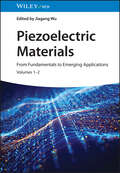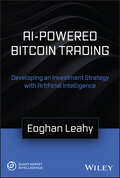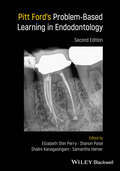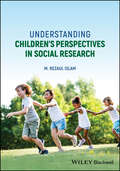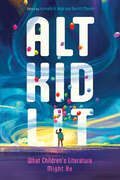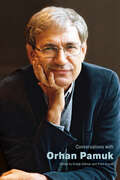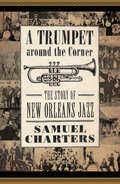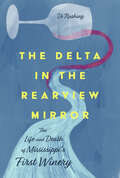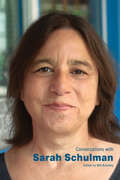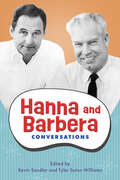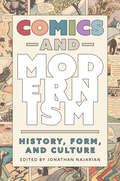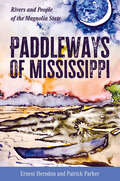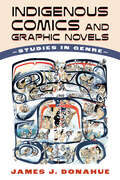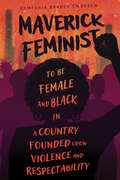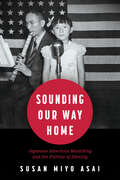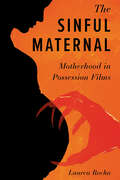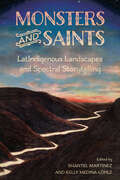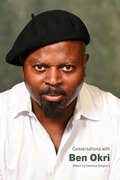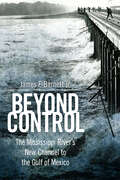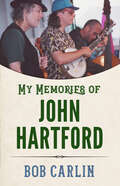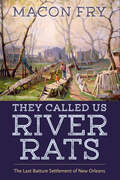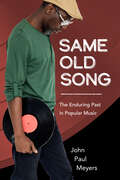- Table View
- List View
Piezoelectric Materials: From Fundamentals to Emerging Applications
by Jiagang WuPiezoelectric Materials Analyze the foundational materials of the electronics industry In recent years piezoelectric materials have become one of the world’s most important classes of functional materials. Their ability to convert between mechanical and electrical energy makes them indispensable for sensors, transducers, actuators, catalysts, and many other foundational electronic devices. As electronics industries expand at unprecedented rates, the range of applications for piezoelectric materials continues to grow. Piezoelectric Materials offers a comprehensive overview of this group of materials, its key properties, and its applications. Beginning with the fundamental science of piezoelectric phenomena, it then analyzes different the numerous different classes of piezoelectric materials and their current and future industrial functions. The result is essential for engineers and materials scientists working in any number of areas. Piezoelectric Materials readers will also find: Analysis of materials types include lead-based and lead-free piezoelectric materials, textured piezoceramics, piezoelectric thin films, and many moreDetailed discussion of applications including dielectric energy storage and biomedical technologyAuthorship by a leading researcher of piezoelectric materials Piezoelectric Materials is ideal for materials scientists, electronic engineers, polymer chemists, solid state chemists, and any other researchers or professionals working with these key materials.
Introduction to Animal Behavior and Veterinary Behavioral Medicine
by Meghan E. HerronIntroduction to Animal Behavior and Veterinary Behavioral Medicine Understand and apply key concepts of animal behavior in veterinary practice Animal behavior is a critical aspect of veterinary medicine, often underappreciated despite its pervasiveness throughout the field. Understanding animal behavior can facilitate communication with patients, refine diagnoses and indications of ill health, and aid in processes of learning and socialization. Introduction to Animal Behavior and Veterinary Behavioral Medicine offers a comprehensive overview of the key concepts underlying the behavior of multiple animal species before demonstrating how to apply these concepts clinically. The result is an indispensable resource for veterinary students and practitioners who want to deepen their understanding of patient needs. Introduction to Animal Behavior and Veterinary Behavioral Medicine readers will also find: Comprehensive coverage of companion animal behavior and additional coverage of livestock and wild animal behavior Detailed discussion of topics including social development, animal learning, and applied behavior analysis In depth review of diagnosis and treatment strategies for common behavior disorders in companion animals, extending to various additional species Companion website with videos, handouts for downloading, and links to pertinent scientific articles and informative websites Introduction to Animal Behavior and Veterinary Behavioral Medicine is ideal preparation for veterinary medical students as part of “day one readiness” in their professional careers, as well as veterinary practitioners looking for a solid foundation in animal behavior and the treatment of key issues.
Design of Power Management Integrated Circuits (IEEE Press)
by Bernhard WichtDesign of Power Management Integrated Circuits Comprehensive resource on power management ICs affording new levels of functionality and applications with cost reduction in various fields Design of Power Management Integrated Circuits is a comprehensive reference for power management IC design, covering the circuit design of main power management circuits like linear and switched-mode voltage regulators, along with sub-circuits such as power switches, gate drivers and their supply, level shifters, the error amplifier, current sensing, and control loop design. Circuits for protection and diagnostics, as well as aspects of the physical design like lateral and vertical power delivery, pin-out, floor planning, grounding/supply guidelines, and packaging, are also addressed. A full chapter is dedicated to the design of integrated passives. The text illustrates the application of power management integrated circuits (PMIC) to growth areas like computing, the Internet of Things, mobility, and renewable energy. Includes numerous real-world examples, case studies, and exercises illustrating key design concepts and techniques. Offering a unique insight into this rapidly evolving technology through the author’s experience developing PMICs in both the industrial and academic environment, Design of Power Management Integrated Circuits includes information on: Capacitive, inductive and hybrid DC-DC converters and their essential circuit blocks, covering error amplifiers, comparators, and ramp generators Sensing, protection, and diagnostics, covering thermal protection, inductive loads and clamping structures, under-voltage, reference and power-on reset generation Integrated MOS, MOM and MIM capacitors, integrated inductors Control loop design and PWM generation ensuring stability and fast transient response; subharmonic oscillations in current mode control (analysis and circuit design for slope compensation) DC behavior and DC-related circuit design, covering power efficiency, line and load regulation, error amplifier, dropout, and power transistor sizing Commonly used level shifters (including sizing rules) and cascaded (tapered) driver sizing and optimization guidelines Optimizing the physical design considering packaging, floor planning, EMI, pinout, PCB design and thermal design Design of Power Management Integrated Circuits is an essential resource on the subject for circuit designers/IC designers, system engineers, and application engineers, along with advanced undergraduate students and graduate students in related programs of study.
AI-Powered Bitcoin Trading: Developing an Investment Strategy with Artificial Intelligence
by Eoghan LeahySurvive and thrive amongst the professional traders using sophisticated cryptocurrency analysis and trading techniques The purpose of this book is to provide a concise yet comprehensive background of some effective methods for analyzing markets and creating fully automated AI-optimized trading systems. The book outlines some easy-to-replicate yet highly effective quant trading techniques that can be used for analyzing asset prices and then apply them to Bitcoin prices, showing how to generate actionable insights from data that can be used to create fully automated trading signals and systems. Big data analytics can be enhanced with artificial intelligence techniques. Back testing and optimization methods are presented with a special emphasis placed on the use of distributed genetic algorithms for parameter optimization. Finally, a case study of a fully automated trend-following trading strategy that leverages artificial intelligence is presented. Bitcoin AlphaBot™ combines human insight with AI-driven optimization to build profit table trend trading strategies.
Pitt Ford's Problem-Based Learning in Endodontology
by Elizabeth Shin Perry Shanon Patel Shalini Kanagasingam Samantha HamerPitt Ford’s Problem-Based Learning in Endodontology Pitt Ford’s Problem-Based Learning in Endodontology, 2nd Edition, is an essential reference for Endodontology, enriched with the latest research and clinical evidence. Employing a problem-based approach, it consolidates readers’ knowledge and diagnostic skills. Prepared by an international team of clinical academics, this edition reflects the latest advances in the field. Encouraging self-directed learning, the authors present diverse clinical cases covering topics such as non-odontogenic pain, pulp preservation, endodontic treatment, restoration, regenerative endodontic procedures, and trauma. Each section is accompanied by images as well as further reading recommendations. A touchstone to key areas concerning the dental pulp and the root canal system, Pitt Ford’s Problem-Based Learning in Endodontology is a valuable resource for dental students, residents, and clinicians seeking the latest techniques and procedures in Endodontology.
Applied Coatings: Chemistry, Formulation, and Performance
by Weih Q. LeeAPPLIED COATINGS An integrated collection of case studies providing a concise guide for professionals working with coatings materials in academia and industry In Applied Coatings: Chemistry, Formulation, and Performance, distinguished scientist Dr. Weih Q. Lee delivers an illuminating collection of case studies designed to connect various elements of applied coatings technology. Going beyond generic discussions, the author describes the fundamental chemistry, formulations, and properties of applied coating materials – including the structural and functional components of structure-property relationships – as well as the foundations of applied cure kinetics and the rheology of epoxy coatings. Each chapter is self-contained, comprehensive, and can be read individually, while the book remains technically and editorially integrated. Core themes include structure-performance relationships, formulation index driven experiment design, and consolidated thermal analysis. Readers will also find: A thorough introduction to epoxies and epoxy curing agents, including oxetanes, vinyl esters, glycidyl methacrylate (GMA), isocyanate and silicone crosslinkers, cationic catalysts, acrylate and phenol accelerators, and specialty derivatives Attentive descriptions of epoxy curing chemistry, including epoxy-phenolic, -polyamide, -active ester, and acid- or base-catalyzed systems in a broader scope Comprehensive explorations of cure kinetics and rheology, including model-free kinetics (MFK), the nth-order model covering Kissinger plots and the Borchardt—Daniels (BD) approach, the autocatalytic model, executive quantification via curve fitting of DSC (differential scanning calorimetry) exotherms, the rheology of non-reactive fluids, and the viscoelasticity of reactive coatings Practical discussions of C1S thick-film surface coatings, C2S structural lamination, liquid and powder epoxies, and phenolic coatings, including fluorene monomers, heterocyclic resins, and polymerizable derivatives Complete treatments of coating characterization, microencapsulation, epoxy hybrids and non-epoxy platforms, adhesion of applied coatings, and adhesion promotion, including reactive and functional silicones Perfect for formulation and research and development scientists and engineers at any technical level, Applied Coatings will also benefit research professors and students studying coatings, adhesives, composites, electronic materials, and more.
Understanding Children's Perspectives in Social Research
by M. Rezaul IslamComprehensive exploration of the intricacies and ethical dimensions involved in conducting research with children Understanding Children's Perspectives in Social Research explores how to conduct ethical and meaningful research involving children, covering research methodologies, practical strategies, and more. The book delves into the historical evolution of children's participation in research and elucidates the ethical foundations rooted in the Convention on the Rights of the Child (CRC) and theoretical frameworks such as social constructivism and children's agency, shedding light on the significance of developmental psychology in shaping research methodologies tailored to different age groups. The book also offers insights into designing child-centric research studies that empower children as active contributors, addressing challenges and emphasizing the importance of informed consent, assent, confidentiality, and creating safe, child-friendly research environments. Furthermore, the book underscores the significance of diverse data collection methods that capture children's voices authentically. It explores child-focused interviews, focus groups that encourage peer interaction, and innovative techniques such as visual methods and digital approaches. The book culminates in discussing the implications of children's perspectives for policy, practice, and societal change. Understanding Children's Perspectives in Social Research includes discussion on: Developing a collaborative environment during research participation and the role of comfort and safety in the ethical well-being of children Trust and transparency in parental involvement, understanding and connecting to children through active listening, and using a non-directive style in child-centered conversations Fostering engagement and insights through play and games, amplifying voices through storytelling, and exploring emotions in reflective play Embracing technological advancements and envisioning an inclusive future that acknowledges the impact of children's perspectives on various spheres of society Covering ethical considerations, research methodologies, practical strategies, and much more, Understanding Children's Perspectives in Social Research serves as a highly valuable guide for researchers, educators, policymakers, and advocates committed to engaging with children's voices in a respectful, ethical, and meaningful manner.
Alt Kid Lit: What Children's Literature Might Be (Children's Literature Association Series)
by Kenneth B. Kidd and Derritt MasonContributions by Kristopher Alexander, Amanda K. Allen, Brianna Anderson, Catherine Burwell, Katharine Capshaw, Negin Dahya, Gabriel Duckels, Paige Gray, Gabrielle Atwood Halko, Natasha Hurley, Kenneth B. Kidd, Erica Law-Montes, Derritt Mason, Brandon Murakami, Tehmina Pirzada, Cristina Rhodes, Cristina Rivera, Jakob Rosendal, TreaAndrea M. Russworm, Vivek Shraya, Victoria Ford Smith, Joshua Whitehead, and Shuyin Yu How do we think about children’s and young adult literature? Children’s literature is often defined through audience, so what happens when children are drawn to and claim genres not built expressly “for” them? To what extent do canonical formations tend to overwrite or obscure less visible efforts to create and promote material for the young? These are the driving questions of Alt Kid Lit: What Children's Literature Might Be. Contributors to the volume offer theoretical meditations on the category of children’s and young adult literature as well as case studies of materials that complicate our understanding of such. Chapters attend to a diverse array of subjects including the “non-places” of children’s literature; child mediums; Black theater for children; children’s interpretive drawings; fanfiction; Latinx, Indigenous, and silkpunk speculative fiction; environmental zines; shōnen anime; Jim Henson's The Dark Crystal; South Asian television; and “emergency children’s literature.” The book also features interviews with two experimental writers about genre and alt-publishing and a roundtable conversation on video games and children’s digital engagements. Building on diverse approaches including queer theory and postcolonial studies, Alt Kid Lit shines light on materials, methodologies, and epistemologies that are sometimes underacknowledged in the field of children’s and young adult literature studies.
Conversations with Orhan Pamuk (Literary Conversations Series)
by Erdağ Göknar and Pelin KıvrakIn over thirty interviews conducted between 1982 and 2022, Conversations with Orhan Pamuk reveals a writer of intense literary and political engagement.Nobel laureate Orhan Pamuk (b. 1952) is a foremost practitioner of the global novel today. His books have been translated into over sixty languages and sold over fifteen million copies globally. The interviews in this volume open windows onto Pamuk's everyday life, craft, and process, constituting an alternative literary history that provides insights into the novelist's influences, method, form, and content. These conversations reveal that a Pamuk novel is predicated on methodical research, at times archival and scholarly, investigative and journalistic, or ethnographic. They are necessarily instructive and edifying as much as they are entertaining, providing a discursive space of literary history where writing, politics, and the everyday intersect and where the politics of literature can be located.
A Trumpet around the Corner: The Story of New Orleans Jazz (American Made Music Series)
by Samuel ChartersSamuel Charters has been studying and writing about New Orleans music for more than fifty years. A Trumpet around the Corner: The Story of New Orleans Jazz is the first book to tell the entire story of a century of jazz in New Orleans. Although there is still controversy over the racial origins and cultural sources of New Orleans jazz, Charters provides a balanced assessment of the role played by all three of the city's musical lineages--African American, white, and Creole--in jazz's formative years. Charters also maps the inroads blazed by the city's Italian immigrant musicians, who left their own imprint on the emerging styles. The study is based on the author's own interviews, begun in the 1950s, on the extensive material gathered by the Oral History Project in New Orleans, on the recent scholarship of a new generation of writers, and on an exhaustive examination of related newspaper files from the jazz era. The book extends the study area of his earlier book Jazz: New Orleans, 1885-1957, and breaks new ground with its in-depth discussion of the earliest New Orleans recordings. A Trumpet around the Corner for the first time brings the story up to the present, describing the worldwide interest in the New Orleans jazz revival of the 1950s and 1960s, and the exciting resurgence of the brass bands of the last decades. The book discusses the renewed concern over New Orleans's musical heritage, which is at great risk after the catastrophe of Hurricane Katrina's floodwaters.
The Delta in the Rearview Mirror: The Life and Death of Mississippi's First Winery
by Di RushingAfter graduating from Mississippi State University in 1976, Di Rushing and her husband, Sam, found themselves back on their family farm near Merigold, Mississippi, with 350 acres and no real clue what to do. The couple decided to open the first winery in Mississippi, and with it, a successful business was born. Six years later, a small restaurant joined the Delta winery. Both businesses were thriving by 1990, with eight national award-winning wines, a beautiful vineyard, and a successful restaurant.But in March of 1990, a series of unforeseen events rocked the operation. After the Rushings discovered one of the tour guides, Ray Russell, selling drugs in the winery parking lot, they fired him. He responded with a terrorizing vengeance that persisted over the next nine months. In the early morning hours, the former guide broke into the winery, crept into the wine cellar, and released the entire inventory—nearly a quarter of a million dollars’ worth—down the drain. Fortunately, his incompetence thwarted his most destructive intention to blow up the restaurant. In his rampage, he broke all the windows, which allowed the gas from the kitchen oven to escape, sparing the premises. Though the Rushings rebuilt with the help of their community, Russell continued to stalk and threaten the young family. As his menacing behavior continued to escalate, the Rushings closed their business of fourteen years and moved to Ouray, Colorado, where they began rebuilding their lives. Culminating in the sudden, violent murders of Russell, his wife, and his father twenty-five years later, this book tells a story of both shock and resilience, charting Mississippi history in the process.Intertwined with the true crime narrative, The Delta in the Rearview Mirror: The Life and Death of Mississippi’s First Winery details author Di Rushing’s life in and out of Mississippi, including growing up in 1960s Greenville, attending university, traveling overseas, and the relationships she cultivated along the way.
Conversations with Sarah Schulman (Literary Conversations Series)
by Will BrantleyThe twenty-four interviews collected in Conversations with Sarah Schulman, roughly a fifth of those that exist, have enabled Schulman to expound upon her distinctive fusion of art and social commitment. Ranging from major forums to smaller venues, and covering a period of more than thirty years, these interviews provide full evidence of Schulman’s value as a pivotal player in the intellectual life of her time. Schulman’s career as a writer, activist, teacher, and oral historian is now in its fifth decade. Spanning multiple fiction genres, her eleven novels include After Delores (1988), Rat Bohemia (1995), The Child (2007), and Maggie Terry (2018). A native New Yorker, Schulman (b. 1958) writes for the people that she writes about—women and men making the most of a society that seems continually marked by homophobia, which Schulman regards as less a phobia than an unacknowledged pleasure system. Readers have come to relish Schulman’s provocations, nowhere more so than through her books of nonfiction on topics such as gentrification and the interlocking nature of conflict and abuse. And since the early 1980s, when Schulman worked as a journalist, readers have come to applaud her searing indictments of the nation’s woeful response to its AIDS crisis. Schulman has received the Kessler Award from CLAGS: The Center for LGBTQ Studies in honor of her body of work that has influenced the field of gay and lesbian studies, as well as the Bill Whitehead Award from Publishing Triangle for lifetime achievement. She holds an endowed chair in creative writing at Northwestern University.
Hanna and Barbera: Conversations (Television Conversations Series)
by Kevin Sandler and Tyler Solon WilliamsHanna and Barbera: Conversations presents a lively portrait of Bill Hanna and Joe Barbera, the influential producers behind Tom and Jerry, the Flintstones, Scooby-Doo, the Smurfs, and hundreds of other cartoon characters who continue to entertain the world today. Encompassing more than fifty years of film and television history, the conversations in this volume include first-person accounts by the namesakes of the Hanna-Barbera studio as well as recollections by artists and executives who worked closely with the pair for decades. It is the first collection of its kind about Hanna and Barbera, likely the most prolific animation producers of the twentieth century, whose studio once outflanked its competitor Walt Disney in output and influence.Bill Hanna fell into animation in 1930 at the Harman-Ising studio in Los Angeles, gaining skills across the phases of production as MGM opened its animation studio. Joe Barbera, a talented and sociable artist, entered the industry around the same time at the wild and woolly Van Beuren studio in Manhattan, learning the ins and outs of animation art before crossing the country to join MGM. In television, Hanna’s timing and community-oriented work ethic along with Barbera’s knack for sales and creating funny characters enabled Hanna-Barbera to build a roster of beloved cartoon series. A wide range of pieces map Hanna and Barbera’s partnership, from their early days in Hollywood in the 1930s to Cartoon Network in the 1990s, when a new generation took the reins of their animation studio. Relatively unknown when they made over one hundred Tom and Jerry theatrical cartoons at MGM in the 1940s and 1950s, Hanna and Barbera became household names upon entering the new medium of television in 1957. Discussions here chart their early primetime successes as well as later controversies surrounding violence, overseas production, and the lack of quality in their Saturday morning cartoons. With wit, candor, insight, and bravado, Hanna and Barbera: Conversations reflects on Bill and Joe’s breakthroughs and shortcomings, and their studio’s innovations and retreads.
Comics and Modernism: History, Form, and Culture (Tom Inge Series on Comics Artists)
by Jonathan NajarianContributions by David M. Ball, Scott Bukatman, Hillary Chute, Jean Lee Cole, Louise Kane, Matthew Levay, Andrei Molotiu, Jonathan Najarian, Katherine Roeder, Noa Saunders, Clémence Sfadj, Nick Sturm, Glenn Willmott, and Daniel Worden Since the early 1990s, cartoonist Art Spiegelman has made the case that comics are the natural inheritor of the aesthetic tradition associated with the modernist movement of the early twentieth century. In recent years, scholars have begun to place greater import on the shared historical circumstances of early comics and literary and artistic modernism. Comics and Modernism: History, Form, and Culture is an interdisciplinary consideration of myriad social, cultural, and aesthetic connections. Filling a gap in current scholarship, an impressively diverse group of scholars approaches the topic from a variety of disciplinary backgrounds and methodologies. Drawing on work in literary studies, art history, film studies, philosophy, and material culture studies, contributors attend to the dynamic relationship between avant-garde art, literature, and comics. Essays by both established and emerging voices examine topics as divergent as early twentieth-century film, museum exhibitions, newspaper journalism, magazine illustration, and transnational literary circulation. In presenting varied critical approaches, this book highlights important interpretive questions for the field. Contributors sometimes arrive at thoughtful consensus and at other times settle on productive disagreements. Ultimately, this collection aims to extend traditional lines of inquiry in both comics studies and modernist studies and to reveal overlaps between ostensibly disparate artistic practices and movements.
Paddleways of Mississippi: Rivers and People of the Magnolia State
by Ernest Herndon Patrick ParkerMississippi rivers and creeks have shaped every aspect of the state’s geology, ecology, economy, settlement, and politics. Mississippi's paddleways—its rivers, rills, creeks, and streams—are its arteries, its lifeblood, and the connective tissues that tie its stories and histories together and flood them with a sense of place and impel them along the current of time. The rivers provide structure for the telling of stories. In Paddleways of Mississippi: Rivers and People of the Magnolia State, readers will discover flowing details of virtually every waterway in the state—the features, wildlife, vegetation, geology, hydrology, and specific challenges to be expected—alongside many wonderful historical and social accounts specific to each system. Interviews and oral histories enliven these waterways with evocative scenery, engaging anecdotes, interesting historical tales, and personal accounts of the people and communities that arose along the waterways of Mississippi. Part natural history, part narrative nonfiction, Paddleways of Mississippi will appeal to outdoor enthusiasts, anglers, naturalists, campers, and historians, and is suitable for novices as well as experts. Told together, the pieces included are a social and ecological history that exposes and deepens the connection coursing between the people and the rivers.
Indigenous Comics and Graphic Novels: Studies in Genre
by James J. DonahueIn recent years, studios like Marvel and DC have seen enormous success transforming comics into major motion pictures. At the same time, bookstores such as Barnes & Noble in the US and Indigo in Canada have made more room for comic books and graphic novels on their shelves. Yet despite the sustained popular appeal and the heightened availability of these media, Indigenous artists continue to find their work given little attention by mainstream publishers, booksellers, production houses, and academics. Nevertheless, Indigenous artists are increasingly turning to graphic narratives, with publishers like Native Realities LLC and Highwater Press carving out ever more space for Indigenous creators. In Indigenous Comics and Graphic Novels: Studies in Genre, James J. Donahue aims to interrogate and unravel the disparities of representation in the fields of comics studies and comics publishing. Donahue documents and analyzes the works of several Indigenous artists, including Theo Tso, Todd Houseman, and Arigon Starr. Through topically arranged chapters, the author explores a wide array of content produced by Indigenous creators, from superhero and science fiction comics to graphic novels and experimental narratives. While noting the importance of examining how Indigenous works are analyzed, Donahue emphasizes that the creation of artistic and critical spaces for Indigenous comics and graphic novels should be an essential concern for the comics studies field.
Maverick Feminist: To Be Female and Black in a Country Founded upon Violence and Respectability
by Kemeshia Randle SwansonBeginning with their forced introduction to American soil, Black women have relied on maverick-like characteristics to survive. And yet, these liberating qualities have been repeatedly disparaged by the masses in favor of an elitist politics of respectability. In Maverick Feminist: To Be Female and Black in a Country Founded upon Violence and Respectability, scholar Kemeshia Randle Swanson examines the extent to which the politics of respectability diminish joy and increase sorrow throughout the lifespan of Black women. By rejecting this damaging standard in society, Black women can wholly and attentively assist in the obliteration of racist, sexist, classist, and ableist oppression. But first, they must work towards becoming self-identified, self-actualized, and self-sexualized.Bridging the gap between women in both the streets and the academy, Maverick Feminist expands the traditional understandings of activism and enlarges discussions about Black female sexuality. Swanson emphasizes sexuality’s significance to the literary and sociopolitical success of Black women of the past and in this contemporary climate. Through close readings and critical analyses of fiction, nonfiction, and popular culture, Swanson argues that #BlackGirlMagic and racial progression require rejecting respectability politics and developing an intimate appreciation of self. Maverick Feminist examines texts by and about bold Black women, including Zora Neale Hurston’s Their Eyes Were Watching God, Sister Souljah’s The Coldest Winter Ever, Brittney Cooper’s Eloquent Rage: A Black Feminist Discovers Her Superpower, Alice Walker’s The Color Purple, Sapphire’s PUSH, Roxane Gay’s Hunger: A Memoir of (My) Body, Terry McMillan’s Getting to Happy, and Michelle Obama’s Becoming.Maverick Feminist offers hope concerning the growing divide between scholars and the communities about which they theorize. The book celebrates centuries of agency and control that Black women have mustered and maintained in a world that seems to want nothing more than to see them prone and powerless. Ultimately, maverick feminism provides a freer means of living out, evaluating, understanding, and improving the lives of Black women.
Sounding Our Way Home: Japanese American Musicking and the Politics of Identity
by Susan Miyo AsaiA product of twenty-five years of archival and primary research, Sounding Our Way Home: Japanese American Musicking and the Politics of Identity narrates the efforts of three generations of Japanese Americans to reach “home” through musicking. Using ethnomusicology as a lens, Susan Miyo Asai examines the musical choices of a population that, historically, is considered outside the racial and ethnic boundaries of American citizenship. Emphasizing the notion of national identity and belonging, the volume provokes a discussion about the challenges of nation-building in a democratic society.Asai addresses the politics of music, interrogating the ways musicking functions as a performance of social, cultural, and political identification for Japanese Americans in the United States. Musicking is an inherently political act at the intersection of music, identity, and politics, particularly if it involves expressing one’s ethnicity and/or race. Asai further investigates how Japanese American ethnic identification and cultural practices relate to national belonging. Musicking cultivates a narrative of a shared history and aesthetic between performers and listeners. The discourse situates not only Japanese Americans, but all Asians into the Black/white binary of race relations in the United States.Sounding Our Way Home contributes to the ongoing struggle for acceptance and equal representation for people of color in the US. A history of Japanese American musicking across three generations, the book unveils the social and political discrimination that nonwhite immigrants and their offspring continue to face when it comes to finding acceptance in US society and culture.
The Sinful Maternal: Motherhood in Possession Films (Horror and Monstrosity Studies Series)
by Lauren RochaPregnancy, birth, and postpartum recovery are challenging experiences that impact women’s physical, mental, and emotional health in ways that have been historically minimalized, dismissed, or neglected. A mother’s body becomes a public body, physically and politically not her own, instead shared by her spouse, her children, and those around her. Her body, therefore, makes the perfect vessel for an invasive presence—or possession. The Sinful Maternal: Motherhood in Possession Films examines the role of mothers and motherhood in ten possession films, including Rosemary’s Baby, The Exorcist, The Babadook, and Hereditary. Chapters discuss the work of such directors as James Wan, Jennifer Kent, Robert Eggers, and Ari Aster to address how their cinematic approaches to these films produce rich possession narratives that explore different facets of motherhood and women’s agency. Working at the intersections of gender studies, architectural theory, trauma studies, and monster theory, with a particular focus on the treatment of (often unruly) female bodies, author Lauren Rocha investigates the ways in which motherhood is a fertile state for possession and how possession acts to influence, destabilize, and reshape identity and the self. Placing the films in chronological order, she closely analyzes the ways in which sociocultural influences create different roles women and mothers are expected to perform. Ultimately, Rocha demonstrates how possession offers a way to challenge performative motherhood to free the self.
Monsters and Saints: LatIndigenous Landscapes and Spectral Storytelling (Horror and Monstrosity Studies Series)
by Shantel Martinez and Kelly Medina-LópezContributions by Kathleen Alcalá, Sarah Amira de la Garza, Sarah De Los Santos Upton, Moises Gonzales, Luisa Fernanda Grijalva-Maza, Leandra Hinojosa Hernández, Spencer R. Herrera, Brenda Selena Lara, Susana Loza, Juan Pacheco Marcial, Amanda R. Martinez, Diana Isabel Martínez, Shantel Martinez, Diego Medina, Kelly Medina-López, Cathryn J. Merla-Watson, Arturo “Velaz” Muñoz, Eric Murillo, Saul Ramirez, Roxanna Ivonne Sanchez-Avila, ire’ne lara silva, Lizzeth Tecuatl Cuaxiloa, and Bianca Tonantzin Zamora Monsters and Saints: LatIndigenous Landscapes and Spectral Storytelling is a collection of stories, poetry, art, and essays divining the contemporary intersection of Latinx and Indigenous cultures from the American Southwest, Mexico, and Central and South America. To give voice to this complicated identity, this volume investigates how cultures of ghost storytelling foreground a sense of belonging and home in people from LatIndigenous landscapes. Monsters and Saints reflects intersectional and intergenerational understandings of lived experiences, bodies, and traumas as narrated through embodied hauntings. Contributions to this anthology represent a commitment to thoughtful inquiry into the ways storytelling assigns meaning through labels like monster, saint, and ghost, particularly as these unfold in the context of global migration. For many marginalized and displaced peoples, a sense of belonging is always haunted through historical exclusion from an original homespace. This exclusion further manifests as limited bodily autonomy. By locating the concept of “home” as beyond physical constructs, the volume argues that spectral stories and storytelling practices of LatIndigeneity (re)configure affective states and spaces of being, becoming, migrating, displacing, and belonging.
Conversations with Ben Okri (Literary Conversations Series)
by Vanessa GuigneryConversations with Ben Okri collects twenty-six interviews that range from 1986 to 2023 and reflect the international resonance of Nigerian writer Ben Okri's work. The reader is given access to the various phases of Okri’s life and career, beginning with his childhood (b. 1959) and upbringing in Nigeria and the publication of his early short stories and novels. The interviews also explore the tremendous success of The Famished Road (for which Okri became the first Black African writer to receive the Booker Prize in 1991) and the dazzling creativity of his subsequent work in a multiplicity of literary genres. The volume offers insight into the writer’s creative process and his unique views on literature, history, memory, politics, freedom, spirituality, and environmental issues. The conversations often veer into fascinating philosophical discussions about the nature of art and reality, the value of myth, and the dynamics of storytelling.Since the publication of his first novel in 1980, Okri has encouraged his readers to open their minds and eyes to new modes of perceiving reality. Convinced of the universality of art, he has been intent on redreaming the world from a variety of perspectives in poems, essays, short stories, novels, and plays written over a period of more than forty years. Throughout his career, Ben Okri has never stopped experimenting with new forms, creating the stoku (a mixture of short story and haiku), endowing his fictional and nonfictional creations with poetic undertones, and collaborating with visual artists, musicians, and dancers.
Beyond Control: The Mississippi River’s New Channel to the Gulf of Mexico (America's Third Coast Series)
by James F. Barnett Jr.Beyond Control reveals the Mississippi as a waterway of change, unnaturally confined by ever-larger levees and control structures. During the great flood of 1973, the current scoured a hole beneath the main structure near Baton Rouge and enlarged a pre-existing football-field-size crater. That night the Mississippi River nearly changed its course for a shorter and steeper path to the sea. Such a map-changing reconfiguration of the country’s largest river would bear national significance as well as disastrous consequences for New Orleans and towns like Morgan City, at the mouth of the Atchafalaya River. Since 1973, the US Army Corps of Engineers Control Complex at Old River has kept the Mississippi from jumping out of its historic channel and plunging through the Atchafalaya Basin to the Gulf of Mexico. Beyond Control traces the history of this phenomenon, beginning with a major channel shift around 3,000 years ago. By the time European colonists began to explore the Lower Mississippi Valley, a unique confluence of waterways had formed where the Red River joined the Mississippi, and the Atchafalaya River flowed out into the Atchafalaya Basin. A series of human alterations to this potentially volatile web of rivers, starting with a bend cutoff in 1831 by Captain Henry Miller Shreve, set the forces in motion for the Mississippi’s move into the Atchafalaya Basin. Told against the backdrop of the Lower Mississippi River’s impending diversion, the book’s chapters chronicle historic floods, rising flood crests, a changing strategy for flood protection, and competing interests in the management of the Old River outlet. Beyond Control is both a history and a close look at an inexorable, living process happening now in the twenty-first century.
My Memories of John Hartford (American Made Music Series)
by Bob CarlinMy Memories of John Hartford is a memoir about author Bob Carlin's years working alongside singer, songwriter, banjoist, and fiddler John Hartford (1937-2001). Throughout his short life, Hartford was a hit tunesmith, festival headliner, and godfather of newgrass music. He also made contributions to the film and television industry as a star in The Smothers Brothers Comedy Hour and The Glen Campbell Goodtime Hour and helped create the soundtrack for O Brother, Where Art Thou?Carlin and Hartford first met when Carlin interviewed the entertainer for Fresh Air with Terry Gross. From this first meeting over microphones developed a sixteen-year affiliation. Six years into their friendship, a working collaboration grew between the two. Carlin first accompanied John Hartford on several albums, eventually becoming his project manager for audio and video recordings. Finally, Carlin was recruited into John Hartford's last Stringband, for which he also served as the de facto road manager and right-hand guy. My Memories of John Hartford opens with an overview of the years before Hartford and Carlin's friendship, then details the last fifteen years of John Hartford's life. Included are in-depth descriptions of Hartford's lifestyle, as well as his philosophies about music, performing, recording, and living as he expressed them to the author or to those around him, with some road stories thrown in for good measure. And, those last fifteen years of his short life, while tempered by available information, are viewed here through the impressionist lenses of the author's own experience.
They Called Us River Rats: The Last Batture Settlement of New Orleans
by Macon FryThey Called Us River Rats: The Last Batture Settlement of New Orleans is the previously untold story of perhaps the oldest outsider settlement in America, an invisible community on the annually flooded shores of the Mississippi River. This community exists in the place between the normal high and low water line of the Mississippi River, a zone known in Louisiana as the batture. For the better part of two centuries, batture dwellers such as Macon Fry have raised shantyboats on stilts, built water-adapted homes, foraged, fished, and survived using the skills a river teaches. Until now the stories of this way of life have existed only in the memories of those who have lived here. Beginning in 2000, Fry set about recording the stories of all the old batture dwellers he could find: maritime workers, willow furniture makers, fishermen, artists, and river shrimpers. Along the way, Fry uncovered fascinating tales of fortune tellers, faith healers, and wild bird trappers who defiantly lived on the river. They Called Us River Rats also explores the troubled relationship between people inside the levees, the often-reviled batture folks, and the river itself. It traces the struggle between batture folks and city authorities, the commercial interests that claimed the river, and Louisiana’s most powerful politicians. These conflicts have ended in legal battles, displacement, incarceration, and even lynching. Today Fry is among the senior generation of “River Rats” living in a vestigial colony of twelve “camps” on New Orleans’s river batture, a fragment of a settlement that once stretched nearly six miles and numbered hundreds of homes. It is the last riparian settlement on the Lower Mississippi and a contrarian, independent life outside urban zoning, planning, and flood protection. This book is for everyone who ever felt the pull of the Mississippi River or saw its towering levees and wondered who could live on the other side.
Same Old Song: The Enduring Past in Popular Music (American Made Music Series)
by John Paul MeyersPopular music and its listeners are strongly associated with newness and youth. Young people can stay up late dancing to the latest hits and use cutting-edge technology for listening to and sharing fresh music. Many young people incorporate their devotion to new artists and styles into their own developing personalities. However, if popular music is a genre meant for the youthful, what are listeners to make of the widespread sampling of music from decades-old R&B tracks, sold-out anniversary tours by aging musicians, retrospective box sets of vintage recordings, museum exhibits, and performances by current pop stars invoking music and images of the past? In Same Old Song: The Enduring Past in Popular Music, John Paul Meyers argues that these phenomena are part of what he calls “historical consciousness in popular music.” These deep relationships with the past are an important but underexamined aspect of how musicians and listeners engage with this key cultural form. In chapters ranging across the landscape of twentieth- and twenty-first-century music, Meyers finds indications of historical consciousness at work in multiple genres. Rock music canonizes its history in tribute performances and museums. Jazz and pop musicians cover tunes from the “Great American Songbook.” Hip-hop and contemporary R&B singers invoke Black popular music from the 1960s and 1970s. Examining the work of influential artists like Ella Fitzgerald, Bob Dylan, Miles Davis, Kanye West, Prince, D’Angelo, and Janelle Monáe, Meyers argues that contemporary artists’ homage to the past is key for understanding how music-lovers make meaning of popular music in the present.
